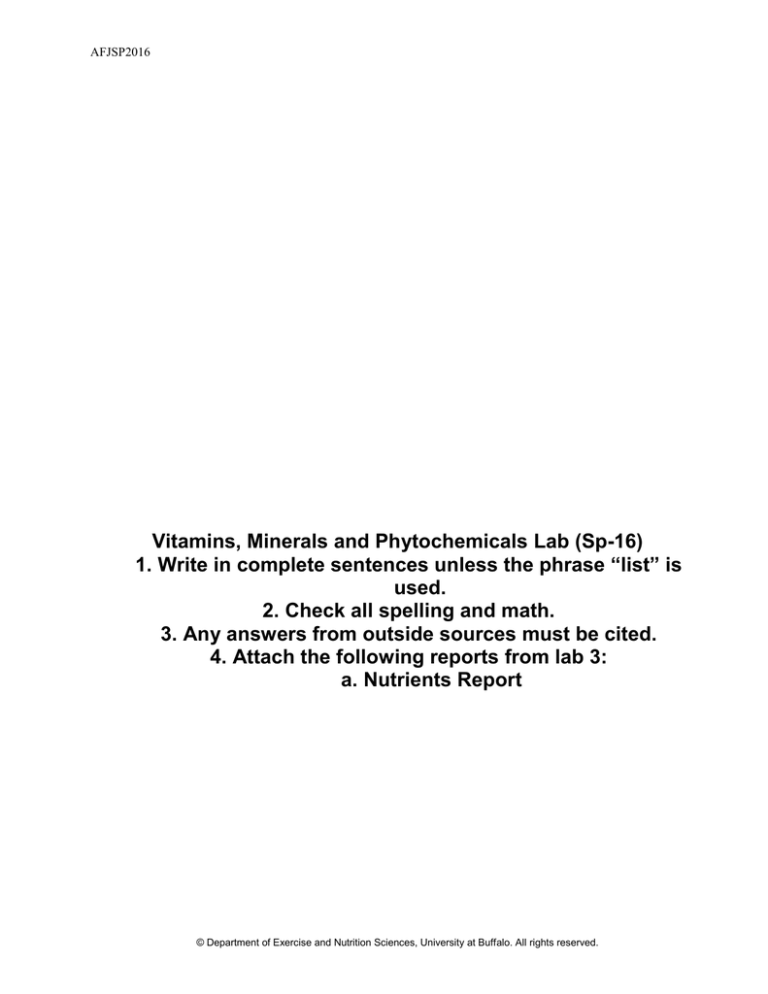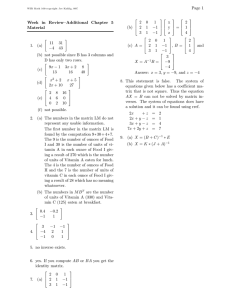
AFJSP2016
Vitamins, Minerals and Phytochemicals Lab (Sp-16)
1. Write in complete sentences unless the phrase “list” is
used.
2. Check all spelling and math.
3. Any answers from outside sources must be cited.
4. Attach the following reports from lab 3:
a. Nutrients Report
© Department of Exercise and Nutrition Sciences, University at Buffalo. All rights reserved.
AFJSP2016
Name:
OnLoen Lee
Date:
March 8, 2016
Vitamin, Mineral and Phytochemical Lab
1.
List the 4 fat soluble vitamins:
1) Vitamin A
2) Vitamin D
3) Vitamin E
4) Vitamin K
2.
For each fat soluble vitamin, list at least 2 foods for each that you consume on a regular
basis which provide that vitamin:
Fat Soluble Vitamin
1) Vitamin A
2) Vitamin D
3) Vitamin E
4) vitamin K
3.
1) cheese
2) milk
3) vegetable oil
4) spinach
Refer to your Nutrient Report results. List the vitamins that you did not consume enough of.
Vitamin
1
Food Sources
1) carrots
2) eggs
3) broccoli
4) kale
Food sources (at least 5 for each deficiency)
Vitamin D
Eggs
Butter
Liver
Salmon
Cheese
Vitamin E
Meat
Vegetable oils
Sunflower seeds
Almonds
spinach
Choline1
Eggs
Peanuts
Liver
Fish
Wheat
http://lpi.oregonstate.edu/mic/other-nutrients/choline
© Department of Exercise and Nutrition Sciences, University at Buffalo. All rights reserved.
AFJSP2016
4.
List 4 vitamins important for energy metabolism and provide 3 good food sources for each:
1) Vitamin B1, Thiamin: pork, sunflower seed, nuts
2) Vitamin B22, Riboflavin: Cheese, almonds, salmon
3) Vitamin B3, Niacin: tuna, liver, chicken
4) Vitamin B7, Biotin: liver, cauliflower, salmon
5.
List the 3 vitamins and 1 mineral that may act as antioxidants and provide 3 good food
source for each:
1) Vitamin A: animal products, carrots and oranges
2) Vitamin C: citrus fruits, bell peppers ,tomatoes
3) Vitamin E: vegetable oils, nuts, seeds
4) Selenium: meats, mushrooms, seafood
6.
In 4 or more sentences, explain the role of antioxidants in our bodies and their benefit to our
health.
From the notes, antioxidants quench free radicals. Vitamin A neutralizes free radicals in
nonsmokers. Vitamin C neutralizes free radicals. Vitamin E protects lipids from free radical
damage and regenerates Vitamin C. Selenium Coenzyme for antioxidant enzymes that work
with Vitamin E.
7.
List 3 important functions of folic acid?
1) DNA synthesis
2) Red blood cell (RBC) formation
3) Birth defect prevention (neural tube defects)
2
http://www.listoffoods.net/wp/b-vitamins/vitamin-b7-biotin/
© Department of Exercise and Nutrition Sciences, University at Buffalo. All rights reserved.
AFJSP2016
8.
List at least 4 good food sources of folic acid:
1) Green leafy veggies
2) Organ meats (liver, kidney)
3) OJ
4) Sprouts
9.
a. What is the name of the condition that folate fortification serves to prevent?
It is Neural tube defects
b. Which foods are enriched/fortified with folic acid to help treat deficiency problems in the
U.S.?
There are pasta, bread and cereal.
10.
Describe at least 4 important functions of calcium in our diet?
1) Bone maintenance and teeth formation
2) Blood pressure regulation
3) Blood clotting
4) Muscle contraction
2
© Department of Exercise and Nutrition Sciences, University at Buffalo. All rights reserved.
AFJSP2016
11.
List at least 5 major food sources of calcium (include 2 plant sources):
1) Milk
2) Yogurt
3) Cheese
4) Legumes
5) Collards
12. According to your Super Tracker Nutrient report.
12a.What is your recommended intake of calcium? __1000 mg______________
12b. What was your average daily intake of calcium? __632 mg_________________
12c. If above recommended intake, list three major food sources of calcium in your diet?
Milk, yogurt, and cheese
12d. If below recommended intake, list two ways you alter your diet to meet your calcium
needs?
Goal: Increase 50 % of my calcium intake
How will you accomplish this? Eat 6 oz. yogurt per day
Goal: Increase 50% of m calcium in a convenient way.
How will you accomplish this? Drink a cup of milk in the morning per day
3.
If someone is lactose intolerant, how can they make sure they are meeting their calcium
needs (list two ways)?
To eat plant sources of calcium like Tofu, green leafy vegetables, almonds, beans.
To eat Calcium-fortified non-dairy like Orange juice, soy milk.
14.
Since sodium intake is related to our risk for developing hypertension, you need to evaluate
whether or not your diet provides an excessive amount of sodium.
14a. According to your Food Analysis 3 day average, what was your sodium intake?
My average is 2298 mg.
14b. What are the recommendations for sodium intake?
The recommended is less than 2300 mg.
14c. Does your intake meet or exceed recommendations?
I met the recommendations but did not exceed recommendations.
3
© Department of Exercise and Nutrition Sciences, University at Buffalo. All rights reserved.
AFJSP2016
15.
List at least three high sodium foods you consume on a regular basis:
Food
16.
Frequency Eaten
Burgers
once a week
Italian salad dressing
twice a week
Bagels
twice a week
What changes can be made to reduce your sodium intake (give two examples)?
1. Goal: Avoid intake of salt
How will you accomplish?: use lemon juice and herbs instead of salt in cooking
2. Goal: drop consumption of Italian salad dressing
How will you accomplish?: Replace the Italian salad with lemon juice and olive oil.
17.
Record your blood pressure (This is to be done in lab class)
Reading #1: __116__/62 mmhg______________
Reading #2 : __118__/ 68 mmhg_____________
18.
Is your blood pressure normal or high? What steps, other than limiting sodium intake, can
someone with high blood pressure take to reduce their blood pressure? (Give 3 examples)
It was normal. Other means are weight loss if overweight, exercise and DASH diet.
19.
According to your SuperTracker Nutrients Report:
19a. What is your recommended intake of iron?
It is 18 mg.
19b. What was your average daily intake of iron?
© Department of Exercise and Nutrition Sciences, University at Buffalo. All rights reserved.
AFJSP2016
It was 11 mg.
19c. Where you below, at, or above your recommended intake?
I was below my recommended intake.
20.
List at least 3 functions of Iron in our bodies?
1) Bind Oxygen in red blood cells
2) Recycle Vitamin C
3) Coenzyme for cellular respiration (make energy)
21.
List at least 3 foods you can eat to eat to improve your intake of iron:
1) Animal sources (Meat, fish, poultry)
2) Leafy greens
3) Beans, nuts and legumes
22.
Should most Americans take daily vitamin and mineral supplements? ___ Only if prescribed
or recommended by doctor___
Explain your answer, in 5-6 complete sentences, giving at least two reasons to support your
answer.
Intake of vitamin and mineral supplements causes of toxicity, especially for fatsoluble vitamins. Some supplements can produce side effects or cause health
concerns. For example, Vitamin K reduce the ability of blood thinners to work. It is not
recommended to take it with doctor’s guidance. Other than that, it is absolutely
possible to get all the necessary nutrients by eating a variety of healthy food.
Therefore, a health balanced diet is better than nutrient supplements.
© Department of Exercise and Nutrition Sciences, University at Buffalo. All rights reserved.
AFJSP2016
Phytochemicals
23. What is a phytochemical?
Phytochemicals are compounds in plants that are not required for normal functioning of the
body, but have a beneficial effect on health or play an active role in preventing or lessening
disease.
24. How can phytochemicals affect our health? List 3 ways.
Promote immune system function
Act directly against bacteria and viruses
Reduce inflammation
25. Describe 3 ways you can incorporate more phytochemicals in your diet.
To replace soda with tea or wine.
To replace soda with tea or wine
To use phytochemical-rich flavoring agents herbs, hot peppers, berries
5
© Department of Exercise and Nutrition Sciences, University at Buffalo. All rights reserved.
AFJSP2016
© Department of Exercise and Nutrition Sciences, University at Buffalo. All rights reserved.








